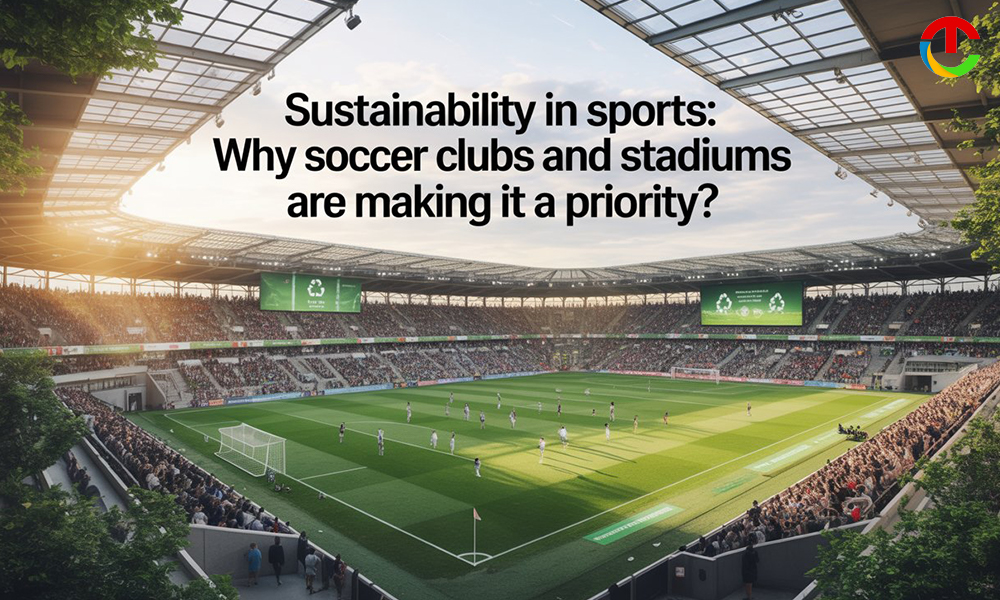Sustainability has been a priority in several sectors for the last few years. It is also in the case of the world of sports that the green movement is adopted. In soccer, this shift has been accelerated due to the charm of the game and the number of audiences surging day by day. The realization of adopting sustainable practices has benefited the environment and also enhanced the fans and players’ experiences to another level.
Measures like investing in LED lighting, HVAC smart systems, and water-saving technologies have been taken to navigate through environmental challenges. This has resulted in cost-cutting of up to 20 to 30% while reducing carbon emissions. The Premier League clubs are also contributing significantly towards the sustainability initiative. Tottenham Hotspur operates entirely on renewable energy.
The Rising Importance of Sustainability in Sports
Sports facilities, especially large stadiums, consume massive amounts of energy, water, and resources. From lighting and turf maintenance to waste management and transportation, the environmental footprint is undeniable. With fans, sponsors, and local governments demanding greener practices, clubs are recognizing the urgency to adapt. By integrating sustainability into operations, they are reducing costs, strengthening their reputations, and setting an example for other industries.
How Soccer Clubs Are Leading the Way
Around the world, these football clubs are pioneering innovative practices that place sustainability at the core of their operations. Several stadiums have transitioned to renewable energy sources, installed water recycling systems, and committed to eliminating single-use plastics. These initiatives reflect a broader understanding that environmental responsibility is not optional; it is essential for the sport’s future.
In the United States, Major League Soccer teams have begun to integrate eco-friendly practices. Audi Field in Washington, D.C., for instance, incorporates energy-efficient lighting and advanced irrigation systems. Allianz Field in Minnesota recycles rainwater to maintain its playing surface. These investments demonstrate how sustainability can align with both operational efficiency and fan expectations.
Global Benchmarks for Inspiration
Outside the U.S., examples abound of how stadiums can serve as sustainability leaders. Amsterdam’s Johan Cruyff Arena operates on a cutting-edge battery system that stores energy from solar panels and recycled electric vehicle batteries. Meanwhile, Forest Green Rovers in England have become a symbol of green sports, powering their stadium with renewable energy and offering a fully vegan menu. These benchmarks highlight that sustainability can be a brand-defining identity as well as an operational strategy.
Why Sustainability Resonates with Fans
Fans today, especially younger generations, care deeply about how organizations respond to climate challenges. When clubs implement green initiatives, they not only reduce their carbon footprint but also build stronger connections with supporters. Sustainability becomes part of the fan experience, whether through recycling stations, sustainable merchandise, or eco-friendly transport options.
For football, which thrives on passionate fanbases and community engagement, these efforts carry special weight. Stadiums are more than venues; they are cultural landmarks. By embedding sustainability into these spaces, clubs strengthen their ties with communities while setting an example that extends beyond the pitch.
Business and Strategic Benefits
Beyond environmental impact, sustainable practices deliver clear business advantages. Energy-efficient systems reduce long-term operating costs, while partnerships with eco-conscious sponsors enhance brand image. Municipalities are also more likely to support stadium projects that emphasize sustainability.
Investors increasingly view environmental, social, and governance (ESG) standards as critical metrics. By prioritizing sustainability, clubs demonstrate forward-thinking governance, making them more attractive to stakeholders. For U.S. soccer organizations, this alignment with ESG principles ensures resilience in a competitive sports and entertainment landscape.
Challenges to Overcome
Of course, the path is not without obstacles. Retrofitting older stadiums with modern green technologies requires substantial investment. Smaller clubs may struggle with costs, while larger ones must coordinate across complex networks of stakeholders. Balancing short-term financial pressures with long-term environmental goals remains a challenge.
Nevertheless, the direction is clear. As regulations tighten and public expectations rise, sustainability is becoming a non-negotiable aspect of sports management. Forward-looking clubs are treating it as an investment in their relevance and longevity.
Looking Ahead
The future of soccer will be shaped not only by what happens on the field but also by how clubs respond to global challenges off it. As U.S. cities prepare for major international tournaments, including the 2026 FIFA World Cup, the spotlight will intensify. Stadiums built or renovated for these events must prioritize environmental responsibility to meet both global standards and local community expectations.
This creates an opportunity for American clubs to become leaders in sustainability, showing that the world’s most popular sport can also be the most forward-thinking. By embracing renewable energy, sustainable design, and fan-focused green initiatives, they can ensure that the legacy of upcoming tournaments extends far beyond the games themselves.
Conclusion
Sustainability in sports is no longer an abstract idea; it is a practical necessity shaping how clubs and stadiums operate. In the case of soccer, the global reach of the game amplifies the importance of these efforts. By adopting eco-conscious practices, clubs are not only reducing their environmental impact but also redefining leadership in modern sports.
For the U.S. audience, this movement carries a dual message: sustainability strengthens business outcomes and inspires cultural change. As more clubs and stadiums commit to greener operations, the beautiful game sets an example that progress on the field must be matched by responsibility off it.





